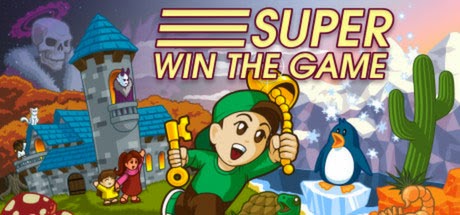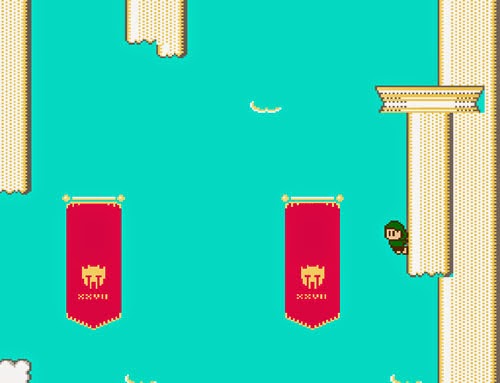A game by Minor Key Games for PC, Mac, and Linux, originally released in 2014.
Super Win the Game is the sequel to the 2012 freeware title, You Have to Win the Game. While the original game hearkened back to the days of 1980’s computer games – complete with limited color CGA and EGA display modes – Super Win the Game offers up an NES-style aesthetic with an expanded color palette, a larger world, and a wider variety of themed locales. The game also features multidirectional scrolling rather than the interconnected single-screen rooms found in the original game.Rather than presenting a single contiguous world, Super Win the Game offers individual towns and dungeons, with an overworld map to connect them all. Similar to the presentation in Zelda II, the world map is top-down with icons representing town and dungeon locations, and entering these areas reveals sidescrolling platforming environments.
The player controls the same character from the first game, and he is addressed here as Wayfarer. An optional introductory tutorial is available, although the starting moveset is quite basic. Players have a 2.5x variable jump, and they must avoid all enemies and spikes lest they be immediately killed. Ringing a bell acts as a checkpoint, and any death returns the player to the last rung bell.
Adding a bit of complexity is the fact that the game features doorways that lead to other areas and into the interiors of buildings, and some of these doors are locked. There are a limited number of keys available to discover around the world, and any key may be used on any door, after which it will be removed from your inventory. However, if you find yourself truly desperate, you may stop by the local Key Lender who will let you borrow one with the understanding that you will pay back your debt if you find another key later on.
Spread around the game world are red gems, 128 in all, many of which require some pretty thorough hunting to track down. Gems allow players to purchase regular keys or skeleton keys, but they are otherwise not required for progress. A large number of these gems are inaccessible with your starting abilities, so players will need to return to previous areas with new abilities if they hope to collect them all. Granted, players are only rewarded with bragging rights, but the layered level designs strongly encourage advanced exploration, and skilled adventurers can rack up a high gem count by the end of the game.
While the original game featured an open world design, Super Win the Game is even more of a non-linear experience. The bulk of the world map is open to the player from the start, and the player may gather many of the gameplay-altering powerups in any order. This is in contrast to the original game that offered red and blue block switches to open new paths that eventually led to the double jump and wall climb abilities. In Super Win the Game, even the first dungeon offers multiple branching paths and navigation that is impacted by the abilities that the player has acquired, thus encouraging a return trip after new powerups have been collected.
Upgrades from the original game make a return and operate in the same fashion. The red orb turns red outlines into solid blocks, and the blue orb does the same for blue outlines, similar to the block switches in Super Mario World. Also available are boots that allow the player to double jump and gloves that allow the player to climb walls.
As mentioned, level designs are layered, so it is very much possible to make it from one end of a dungeon to the other with a certain set of abilities, only to return later with the double jump or wall climb and access an entirely new branch. Thoroughly exploring dungeons – and the game world in general – is required for progress.
There are a couple of other powerups that allow the player a bit of extra environmental exploration to discover hidden platforms and move through certain barriers, but the biggest new addition here is the snorkel powerup.
During the player’s early explorations, he will frequently encounter watery pits that act as obstacle to avoid. In addition, every time the player encounters a bridge on the world map, he must pass through a short platforming section to make his way over the water and continue to the other side. However, once the snorkel is gained, these hydro-hazards suddenly become another avenue for exploration, offering a large new landscape to discover.
The underground waterway system is massive, passing under many of the world map locations and even allowing players to reach alternate dungeon entrances. Players are encouraged to drop down into every pit of water they find to look for gems and other hidden items. There are pools of lava and acid that remain inaccessible… at least until the player gains the proper upgrade. Per platforming conventions, the player is able to jump much higher underwater, but his movement speed is slowed.
In addition to the interconnected waterways, the game features a Subcon area that allows for fast travel between most of the previously explored towns and dungeons. This appears as a dark area with the player character in silhouette, just like the Subcon in Super Mario Bros. 2. Many of the doors in the area can only be opened from the opposite side, so the player must find the corresponding dungeon door in order to make these accessible.
With a large game world and no map or quest log of any kind, players may find themselves wandering around and slowly stumbling across things on their own. However, players may opt to check in with the local fortune teller to find out where they should go next in order to advance. In addition, beyond collecting various powerups, there is a secondary goal to locate all six pieces of the king’s heart. Thorough players may find one or two of these on their own during the course of their adventure, but a certain NPC will offer hints on where to find all of them.
As in the first game, there are numerous instances where the player may find himself moving into an area from which he cannot return (at least not with his starting abilities), and so the player must press ever forward. The player keeps collected gems and keys upon death, so it is possible to explore an alternate path to gather these items and purposely sacrifice the Wayfarer to return to a previous part of the dungeon and take another route.
The game offers more than just an NES-style aesthetic; it also offers throwbacks to some classic platforming tropes, like slippery ice floors, mushrooms that act as trampolines, and a floating platform that changes direction every time you jump on it. There are also a number of false walls that lead to hidden alcoves and alternate passages.
The game also has some specific throwbacks to classic NES games with areas themed to look like levels from Super Mario Bros., Metroid, and Zelda II, as well as specific tiles meant to harken back to classic games, such as the Super Mario Bros. 3-style curtains (which also appeared in You Have to Win the Game).
There is an overarching narrative, but it is designed to be a bit abstruse, with players discovering magic books that transport them into abstract black and white dream worlds where posted signs weave a strange tale. The player also encounters a number of horned Arcadians on his adventure, and they direct him toward specific powerups and offer gems as a reward.
As in the first game, the default video settings present the game with a faux CRT effect, as if you were playing a classic NES game on an old television. This comes complete with pixel bleed and mild blurring and ghosting effects, while the player may tweak the tint and other settings for maximum authenticity. Or, players who prefer hard-edged pixels are free to disable the effect altogether to suit their neo-retro needs.
2D CRED
Super Win the Game was developed by Minor Key Games, a US-based studio founded in 2013 by twin brothers David and J. Kyle Pittman, both of whom have previous experience working professionally in the games industry. David worked at 2K Marin on Bioshock 2 and The Bureau: XCOM Declassified, while Kyle worked at Gearbox Software on Borderlands, Borderlands 2, and Duke Nukem Forever.
You Have to Win the Game
Prior to founding the studio, Kyle worked on his own to develop You Have to Win the Game, which was released as freeware in 2012 under his Pirate Hearts label. You Have to Win the Game laid the basic groundwork for the sequel, with its open game world, exploration-based gameplay, and metroidvania progression system. In 2014, leading up to the release of the sequel, Minor Key Games released an enhanced version of the game, offering a tougher set of remixed levels and the ability to play the entire game as a cat (but with a limit of nine lives).
You Have to Win the Game is presented in a 1980’s computer style, complete with a (optional) computer monitor border with a curved screen and glare effect, and it can be played in 4-color CGA mode or 16-color EGA mode. The player character starts out with just a a 2.5x jump as he explores a large world made up of interconnected single-screen rooms.
As the player collects items, the world slowly opens up, allowing the him to backtrack to previous locations and reach new areas. New abilities include transforming blue and red block outlines into solid blocks to use them as platforms, as well as a double jump and wall jump ability, allowing for some much tougher platforming sequences. The player must explore the world, collect money bags that count toward a completion percentage, and eventually… win the game.
Eldritch
Minor Key Games’ first commercial release was a 3D first person action game called Eldritch, based on the stories of H. P. Lovecraft. The game offers melee-based combat, traditional FPS gunplay, and the use of high explosives to cause massive damage and even blow holes in the walls. The game’s block-based levels are randomly generated.
The player wakes up in a library and discovers a series of glowing books that transport him to several strange worlds filled with monsters. A number of traditional Lovecraftian creatures make an appearance, including fish people, cult members, and strange tentacled beasts, each presented in a somewhat cartoony fashion.
Players are able to kill enemies and loot their bodies to get ammo and money. Money can be used to buy weapons, keys, and gameplay-altering powerups like high jump boots, speed boots, the ability to pick locks and lock doors behind you, and the ability to resurrect yourself (for a price). But beware, looted enemies will respawn elsewhere in the level.
Stealth plays a large role, as the player needs to conserve health and ammunition in order to survive, and the player is rewarded for killing enemies silently or merely sneaking past without engaging them. The game is a roguelike, so if you do manage to get killed, you are sent back to the start of the game with most of your progress reset. The game also features an expansion called Eldritch: Mountains of Madness which places the player in a 10-story dungeon in Antarctica, with a new set of enemies, weapons, and items.





































0 comments:
Post a Comment